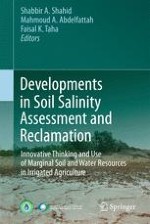Abstract
A large area of Indian soils is of marginal quality with high pH and alkalinity especially in semiarid conditions. Such soils contain excessive sodium salts and possess impermeable hard pan of calcium carbonate below the soil which affects the survival of crops. Currently, these soils are reclaimed by using chemical amendments and mechanical means which exert higher costs, and this practice is repeated every year prior to sowing of crop. In India, per capita land is decreasing every year due to steep rise in population which requires more food to fulfil their requirements. The land is limiting factor. The only way to increase land is through reclamation of abandoned saline and sodic lands and their use for crop production. Permanent reclamation of alkaline soils (high pH) is possible by the adoption of agroforestry system in which trees and crops are grown together which sustain agricultural production and productivity. Keeping in view the seriousness of the problem, an experiment was conducted to improve soil characteristics through agroforestry system for Central Plain Zone of Uttar Pradesh, India. The project was undertaken during the year 1989–2002, at Chandra Shekhar Azad University of Agriculture and Technology, Kanpur, Uttar Pradesh, India. The key objective of the experiment was the selection of suitable multipurpose trees which can improve soil quality of high pH (alkaline soils) for crop. The experiment consists of ten multipurpose tree species, namely, Azadirachta indica, Dalbergia sissoo, Albizia procera, Terminalia arjuna, Eucalyptus hybrid, Leucaena leucocephala, Acacia nilotica, Acacia catechu, Morus alba and Cassia siamea, and in between two rows of trees, agricultural crops were planted. The initial average soil pH, organic carbon and electric conductivity were 10.5, 0.41% and 0.73 dS m−1, respectively. After 12 years experimentation, it was concluded that the planting of multipurpose trees improved the soil organic carbon up to 0.59% and reduced the soil pH up to 8.10 and EC 0.31 dS m−1. The agricultural crops, namely, rice in Kharif (rainy season) and wheat in Rabi (winter season), were found suitable with trees. Among the trees, Eucalyptus hybrid reduces the soil pH and EC drastically as compared to other trees, whereas higher carbon was estimated with Leucaena leucocephala followed by Dalbergia sissoo, Acacia nilotica and Morus alba.
